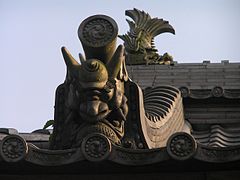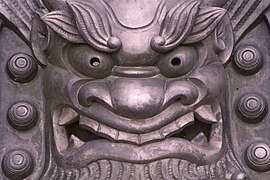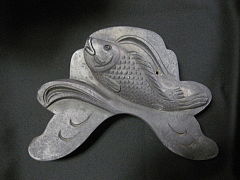Onigawara

Onigawara ( Japanese 鬼 瓦 , "devil-faced roof tile") is a decorative element in Japanese architecture that also serves as a talisman . From a mythological point of view, onigawara in Japanese architecture have a disastrous function similar to that of gargoyles in Western architecture. It is a roof tile that was designed with flower and animal motifs in the Heian and Nara periods , but from the Kamakura period was mostly designed as the face of a goblin ( Oni ). The "Onigawara tile" is usually attached to the end of the roof ridge . Sometimes Onigawara are also made of wood or stone. They often have volute or wave-shaped ornaments called "hire" ( 鰭 , fins ). Plastic onigawara have been made since the Muromachi period .
Examples
Onigawara at Jōdo Temple in Ono
Onigawara at Nijō Castle with a three-leaved mallow as Mon (family coat of arms)
Representing Onigawara, the hermit and shamisen master Kinko
Onigawara with magical hammer motif ( uchide no kozuchi )
literature
- 朽 葉 . In: Noma Seiroku野 間 清 六, Tani Shin'ichi谷 信 一(Ed.):日本 美術 辞典 (Lexicon of Japanese Art). 14th edition. Tōkyodō, Tokyo 1959,pp. 136 .
Web links
- 三 州 鬼 瓦 製造 組合 . Sansyuu-Onigawara-Seizoukumiai, 2007,accessed July 3, 2012.
- 10. 鬼 瓦 . 瓦 歴 史 資料 館, 2007,accessed July 3, 2012(Japanese).
Individual evidence
- ↑ onigawara . JAANUS - Japanese Architecture and Art Net User System, accessed July 4, 2012 .
- ↑ 10. 鬼 瓦 . (No longer available online.) 瓦 歴 史 資料 館 , 2007, archived from the original on December 24, 2012 ; Retrieved July 3, 2012 (Japanese). Info: The archive link was inserted automatically and has not yet been checked. Please check the original and archive link according to the instructions and then remove this notice.








